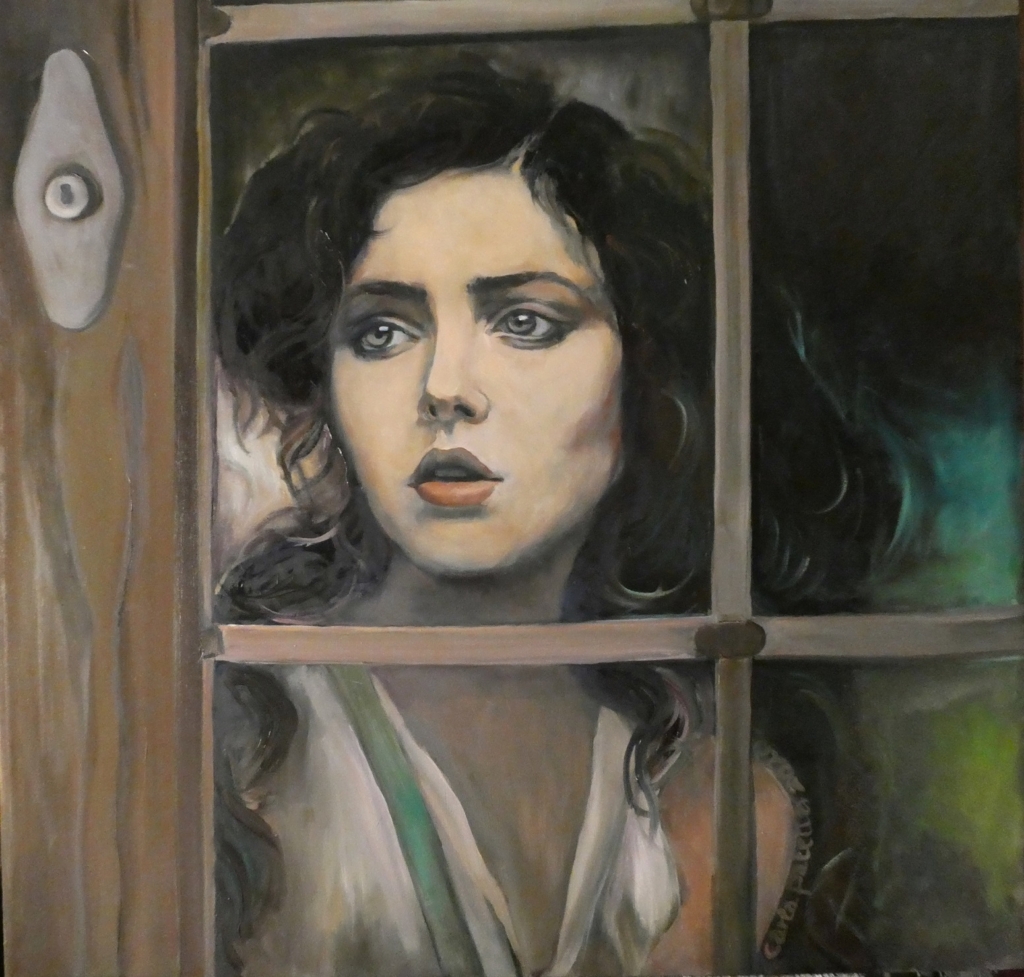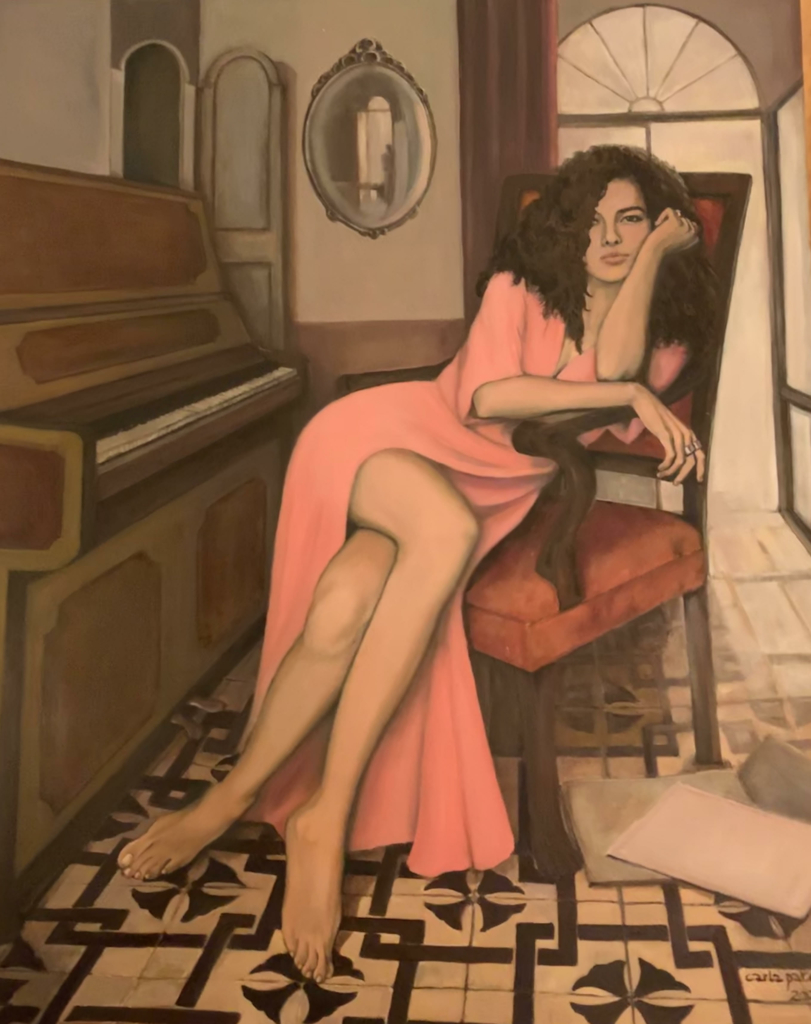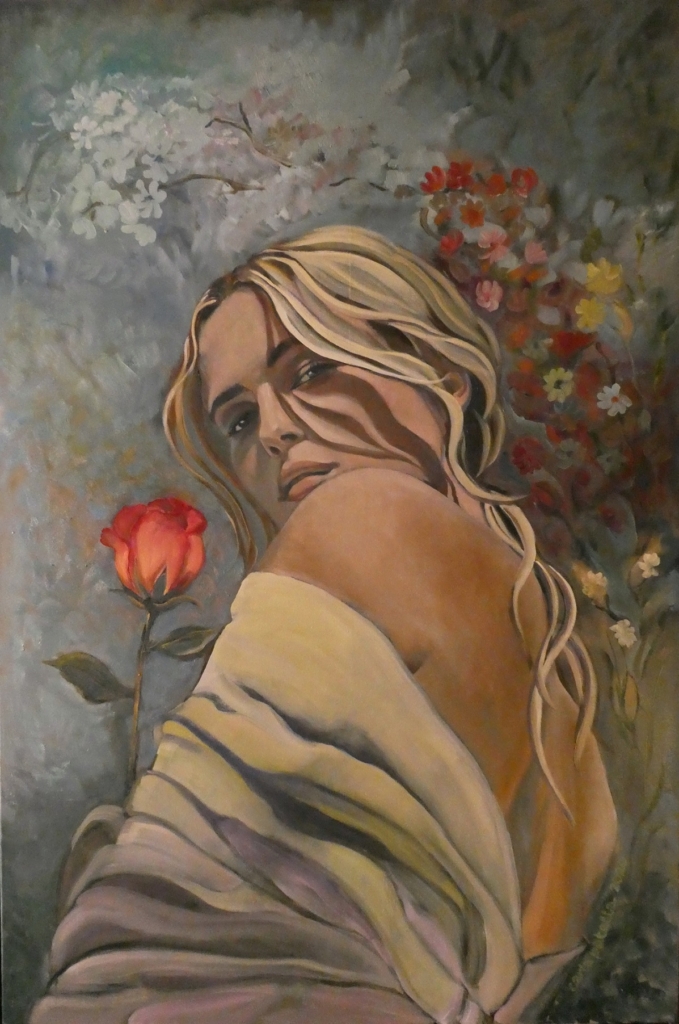di Marta Lock

Bolognese e dunque contraddistinta da una naturale tendenza ad assaporare la vita nella sua pienezza, accogliendone ogni dono e ascoltando le emozioni che da esso derivano, Carla Patella manifesta fin da subito la sua forte inclinazione artistica, pur non avendo inizialmente consapevolezza di quale potesse essere la sua strada all’interno del mondo della creatività. Incoraggiata dalla famiglia e in particolar modo dal padre, decide di intraprendere un percorso di studi che la aiutino a completare la sua formazione e a indirizzarla verso la forma espressiva più affine alle sue corde; si iscrive così al Conservatorio musicale e contemporaneamente alla Scuola d’Arte di Bologna a cui è seguita la scelta di optare per l’Accademia di Belle Arti decretando così la sua scelta dell’arte figurativa. Il suo stile è Realista e svela il suo evidente talento estetico e una solida preparazione accademica sullo studio della prospettiva, del chiaroscuro, della profondità e anche sulla stesura del colore, tutte basi che le hanno permesso nel corso del tempo di andare oltre il senso estetico e l’apparenza dei personaggi raffigurati, spesso donne perché in fondo è proprio in loro che trova una maggiore capacità di liberare le emozioni e approfondirne quel ventaglio di pulsioni interiori, di turbamenti, di nostalgie che chiedono solo di essere scoperte da uno sguardo attento. In fondo il suggerimento di Carla Patella sembra essere quello di non fermarsi alla superficie, di non lasciarsi ingannare o allontanare da una ricca profondità solo perché la protagonista della sensazione vorrebbe celarla per timore di essere scoperta o ferita, oppure per l’errata convinzione che un aspetto piacevole, curato o sicuro di sé non possa nascondere una ricca interiorità o una delicata fragilità. È tutto questo ventaglio di emozioni a essere in primo piano nelle opere della Patella, questo desiderio dell’artista di saper scorgere, attraverso la sua empatica sensibilità, ciò che normalmente potrebbe essere facilmente trascurato da un approccio più distratto, meno vigile verso ciò che si pone davanti agli occhi. La gamma cromatica è sempre tenue, elegante, raffinata, a sottolineare quanto la sostanza possa nascondersi dietro una perfetta forma, quanto la perfezione esterna celi in ogni caso emozioni profonde, insicurezze, riflessioni dentro cui ritrovare se stessi, affrontare un percorso introspettivo che si propaga all’osservatore delle opere perché dalle espressioni colte, dai dettagli, dagli sguardi, egli ritrova se stesso, il proprio stesso sentire, i medesimi dubbi, le perplessità comuni all’essere umano. Nella tela Ai tempi del Coronavirus

la ragazza protagonista è spettatrice di tutto ciò che si trova all’esterno del luogo in cui è costretta a restare, quell’apparente guscio protettivo che in realtà si è trasformato in una gabbia, un impedimento al proseguire dell’esistenza così come concepita fino a qualche tempo prima. Il disorientamento nel suo sguardo è lo stesso che ha avvolto tutta la popolazione mondiale, l’espressione la medesima di chi ha bisogno di ricevere risposte, di sapere quando tutto potrà tornare alla normalità. Tanto quanto in The bride

ciò che emerge è la sensazione di attesa della ragazza, quasi come se in quel suo lasciarsi andare alla riflessione interiore si nascondesse il timore di non essere all’altezza, o al contrario il dubbio che si insinua è sulla scelta che sta per compiere, sul reale desiderio di un cambiamento tanto radicale della propria vita; la Patella ritrae la donna esattamente in quell’istante di dubbio, in quel fisiologico bisogno di una certezza che le potrà dare solo il proseguire quel cammino, il compiere l’esperienza che il suo istinto le ha suggerito di fare. Andiamo ora a conoscere meglio l’artista attraverso le sue risposte.
Carla, la sua vena artistica è emersa fin da bambina tuttavia ha dovuto procedere per tentativi prima di scoprire il suo talento figurativo. Qual è stato il momento esatto in cui ha compreso che la strada giusta, più affine alle sue corde, sarebbe stata quella della pittura?
Non c’è stato un momento esatto piuttosto lo potrei definire un semplice e naturale divenire. Seduta sulle ginocchia di mio padre ho imparato a disegnare e ho dato vita a semplici e avvincentissime storie per la mia tenera età; il disegno che adornava ogni pagina dei miei compiti alle elementari e ha fatto intuire agli insegnati la mia prepotente inclinazione tanto da suggerire caldamente alla mia famiglia di farmi proseguire con studi artistici alle superiori. All’Accademia di Belle Arti ho seguito un corso quadriennale di nudo e anatomia, e nel frattempo ho assecondato il volere materno di integrare gli studi artistici con quelli umanistici.
Nel percorso di studi ha avuto l’opportunità di avvicinarsi a molteplici tecniche pittoriche, su quale base ha scelto la figurazione e dunque il Realismo? È stato un avvicinamento istintivo seguendo la sua natura oppure il termine di una sperimentazione che si è andata definendo con il tempo?
Non saprei dire perché e cosa mi abbia portata verso la pittura; all’Istituto d’Arte nonostante abbia scelto la sezione di pittura, sono stata assegnata alla classe di scultura a causa di un esubero di richieste, peraltro con mio profondo disappunto. Non mi rimaneva che continuare a seguire i miei desideri nella mia casa dove dipingevo per me, gli amici e i parenti. Guardavo le opere classiche dalle quali ero magneticamente attratta mentre a scuola erano gli anni Settanta e la tendenza stilistica dell’epoca andava in tutt’altra direzione.

L’attenzione all’estetica e all’eleganza la avvicina anche all’Art Decò di Tamara De Lempicka, sebbene nel caso della regina del Novecento lo sguardo si soffermasse all’esteriorità, all’apparire piuttosto che all’essere. Quanto è importante sanare la distanza tra forma e sostanza? E quanto è fondamentale per lei svelare le intense profondità delle sue protagoniste a dispetto di una perfezione esteriore che distrae e induce normalmente a soffermarsi sulla superficie della bellezza, piuttosto che andare oltre essa?
Il mio bisogno di circondarmi di bellezza mi porta a ritrarre soggetti molto attraenti attraverso cui cerco di comunicare sentimenti comuni a ciascun individuo. È lo sguardo che, in quanto specchio dell’anima, probabilmente fa la differenza rispetto a una semplice espressione estetica; quello stesso sguardo che attrae magneticamente e che desidera comunicare con l’osservatore.

Quali sono i maestri del passato a cui si ispira e a cui si sente più vicina per intento creativo e approccio stilistico?
Non mi ispiro ad un maestro del passato in particolare, forse per questo mi avvicinano spesso a pittori diversi e molto diversi fra loro. Seicento, Settecento, Ottocento fino ai primi del Novecento: mi sento vicina a tutti i maestri che hanno celebrato la bellezza e l’armonia di forme e colore. La prima cosa che mi chiedo quando inizio un nuovo progetto non è cosa piace al pubblico o cosa va di moda, ma se io vorrei avere quel quadro sotto i miei occhi tutti i giorni.

Lei ha all’attivo molte mostre collettive durante le quali ha ricevuto apprezzamenti dal pubblico e dagli esperti ai lavori. Ci racconta la soddisfazione più grande? Quali sono i suoi prossimi progetti?
La soddisfazione più grande la provo ogni volta che vedo illuminarsi chi occhi di uno spettatore I ricordi belli legati alla mia vita artistica sono molteplici e si giocano tra loro il primo posto. La mia prima personale e prima mostra assoluta, che mi aveva letteralmente costretta a fare una mia cara amica vincendo la mia resistenza a esporre, durante la quale ho visto, con mia grande sorpresa, un afflusso enorme di amici e che facevano tanti apprezzamenti sulle mie opere. La gallerista fu entusiasta per le vendite, malgrado mi avesse messa in guardia sulla possibilità di non vendere nulla proprio perché si trattava di una prima mostra. Erano altri tempi e altro stile pittorico, molto più apprezzato dai critici. Poi una profonda ferita mi ha tenuta lontana dalla pittura per un po’ e quando ho ripreso non ero più la stessa persona. Quella profonda linea di demarcazione si vede chiaramente nei miei dipinti. Tantissimi ricordi mi legano ai maestri con i quali sono entrata maggiormente in sintonia: il Maestro Mazza in Accademia e lo straordinario Wolfango Peretti Poggi. Entrambi hanno saputo accompagnarmi nel mio percorso senza imporre il loro pensiero pittorico. E come non ricordare la grande emozione provata alla stretta di mano di Vittorio Sgarbi? I progetti futuri sono sicuramente quelli di continuare a dipingere e condividere la gioia dei miei risultati con le persone che mi apprezzano, Quando riterrò di avere un certo numero di opere organizzerò una nuova personale. Sicuramente rimarrò in contatto con Editori e Critici che stimo affinché possa far conoscere il mio operato. In fondo come sottolinea spesso Sgarbi, il desiderio più grande di un artista è di essere ricordato.
CARLA PATELLA-CONTATTI
Email: karlotta.pat@gmail.com
Sito web: www.carlapatella.it
Facebook: https://www.facebook.com/carla.patella.14
Instagram: https://www.instagram.com/carla_patella/
Marta Lock’s interviews:
Carla Patella, the journey towards interpreting the multifaceted feelings of the human being
Born in Bologna and therefore characterised by a natural tendency to savour life in its fullness, accepting every gift and listening to the emotions that derive from it, Carla Patella showed her strong artistic inclination right from the start, although she was initially unaware of what her path in the world of creativity might be. Encouraged by her family and especially by her father, she decided to undertake a course of study that would help her to complete her education and direct her towards the form of expression that best suited her heart; she thus enrolled at the Conservatory of Music and at the same time at the School of Art in Bologna, followed by the decision to opt for the Academy of Fine
Arts, thus decreeing her choice of figurative art. Her style is Realist and reveals her evident aesthetic talent and a solid academic preparation in the study of perspective, chiaroscuro, depth and also in the drafting of colour, all bases that have allowed her over time to go beyond the aesthetic sense and appearance of the characters depicted, often women because after all it is in them that she finds a greater ability to release emotions and deepen that range of inner drives, disturbances, nostalgia that only ask to be discovered by a careful look. After all, Carla Patella’s suggestion seems to be not to stop at the surface, not to allow oneself to be deceived or distanced from a rich depth just because the protagonist of the sensation would like to conceal it for fear of being discovered or hurt, or for the mistaken conviction that a pleasant, well-groomed or self-confident appearance cannot hide a rich interiority or a delicate fragility. It is all this range of emotions that is in the foreground in Patella’s artworks, this desire of the artist to be
able to see, through her empathic sensitivity, what could normally be easily overlooked by a more distracted, less vigilant approach to what is placed before the eyes. The range of colours is always soft, elegant and refined, underlining how much substance can be hidden behind a perfect form, how much external perfection conceals deep emotions, insecurities, reflections within which to find oneself, to face an introspective path that spreads to the observer of the paintings because from the captured expressions, from the details, from the looks, he finds himself, his own feelings, the same doubts, the perplexities common to human beings. In the painting At the Time of the Coronavirus, the girl is a spectator of everything outside the place where she is forced to stay, that apparent protective shell which has actually turned into a cage, an obstacle to the continuation of existence as conceived until some time ago. The disorientation in her gaze is the same that has enveloped the entire world population, the expression the same as that
of someone who needs to receive answers, to know when everything will return to normal. As much as in The Bride, what emerges is the girl’s feeling of expectation, almost as if her inner reflection were hiding the fear of not being up to it, or on the contrary, the doubt that creeps in is about the choice she is about to make, about the real desire for such a radical change in her life. Patella portrays the woman exactly in that instant of doubt, in that physiological need for certainty that can only be given by continuing on that path, by fulfilling the experience that her instinct has suggested. Let us now get to know the artist better through her answers.
Carla, your artistic vein emerged as a child, but you had to proceed by trial and error before you discovered your figurative talent. What was the exact moment when you realised that painting would be the right path for you, the one closer to your heart?
There wasn’t an exact moment, rather I would call it a simple and natural becoming. Sitting on my father’s lap, I learnt to draw and created simple and compelling stories for my tender age; the drawing adorned every page of my homework at primary school and made the teachers realise my overbearing inclination, so much so that they strongly suggested to my family that I continue with artistic studies at high school. At the Academy of Fine Arts I took a four-year course in nudity and anatomy, and in the meantime I followed my mother’s wish to integrate my artistic studies with the humanities.
During your studies, you had the opportunity to get to know many different painting techniques; on what basis did you choose figuration and therefore Realism? Was it an instinctive approach following your own nature or was it the end of an experimentation that became more defined over time?
I don’t know why and what led me to painting; at the Art Institute, despite having chosen the painting section, I was assigned to the sculpture class due to an excess of requests, to my deep disappointment. I had no choice but to continue following my desires in my home where I painted for myself, friends and relatives. I looked at classical artworks to which I was magnetically attracted, while at school it was the 1970s and the stylistic trend of the time was in a completely different direction.
.
The focus on aesthetics and elegance also brings you close to Tamara De Lempicka’s Art Deco, although in the case of the queen of the 20th century, the focus was on the exterior, on appearance rather than on being. How important is it to heal the distance between form and substance? And how important is it for you to unveil the intense depths of your protagonists in spite of an exterior
perfection that distracts and normally leads you to dwell on the surface of beauty rather than go beyond it?
My need to surround myself with beauty leads me to portray very attractive subjects through which I try to communicate feelings common to each individual. It is the gaze that, as the mirror of the soul, probably makes the difference to a simple aesthetic expression; that same gaze that magnetically attracts and wants to communicate with the viewer.
Who are the masters of the past who inspire you and who are closest to you in terms of creative intent and stylistic approach?
I am not inspired by a master from the past in particular, perhaps this is why people often compare me to different painters. Seventeenth century, eighteenth century, nineteenth century up to the early twentieth century: I feel close to all the masters who celebrated beauty and harmony of form and colour. The first thing I ask myself when I start a new project
is not what the public likes or what is fashionable, but whether I would like to have that painting before my eyes every day.
You have had many group exhibitions in which you have received praise from the public and experts. Can you tell us your greatest satisfaction? What are your next projects?
My greatest satisfaction is every time I see a viewer’s eyes light up.
There are many good memories of my artistic life, and they all compete for first place. My first solo exhibition and first absolute exhibition, which a dear friend of mine literally forced me to do by overcoming my resistance to exhibiting, during which I saw, to my great surprise, a huge influx of friends and who made so many comments on my work. The entusiasm of the gallery owner about the sales, despite the fact that she had warned me about the possibility of not
selling anything because it was a first exhibition. It was a different time and a different style of painting, much more appreciated by the critics. Then a deep wound kept me away from painting for a while and when I started again, I was no longer the same person. That deep dividing line is clearly visible in my paintings. I have so many memories of the masters with whom I was most in tune: Maestro Mazza at the Academy and the extraordinary Wolfango Peretti Poggi. They both knew how to accompany me on my path without imposing their pictorial thinking. And how can we not remember the great emotion I felt when I shook hands with Vittorio Sgarbi? My future plans are certainly to continue painting and to share the joy of my achievements with people who appreciate me. When I feel that I have a certain number of artworks, I will organise a new personal exhibition. I will certainly keep in touch with editors and critics whom I respect so that I can make my work known.
After all, as Sgarbi often emphasises, an artist’s greatest desire is to be remembered.
